Days 30, 31, and 32: Pride. Prejudice. Proofboxes.
I had (and took) the opportunity the other night to display my gluttony more overtly than ever before. Using the dough we had created on Day 30 and retarded overnight, we each created a number of pizzas. Pizza carbonara was the one I ate most fervently, but then anything combining bacon and cream usually would be. Ranking closely behind that sublime, rich combination were large bites of my own and other students’ creations, including but certainly not limited to four cheese; three cheese and pepperoni; prosciutto with garlic, sage and goat cheese; puttanesca (anchovy, caper, and olive); and good old Margherita. This was real pizza, too – thin, crisp-crusted “New York” pizza, which is to say, Italian pizza. The brick pizza ovens used in Italy (and New York, for that matter) reach about eight hundred degrees Fahrenheit. We had to settle for a mere five hundred fifty, but our crusts firmed to a state of delightful crunchiness even so. Oven temperatures aside, I’m slightly disturbed at my own lack of shame (nay, pride) in the amount I’m willing to eat while others egg me on. I remember days when I would sneak off for this sort of thing, so the opportunities were rarer. Now, I’m on a low-dignity diet. I’m enjoying it thoroughly but I’m not sure it’s working.
Using a very similar, if slightly wetter dough, we also crafted a bit of focaccia. I used fresh oregano and parmesan cheese on mine, seasoning it with salt and pepper, and a bit of minced anchovy. You’ll see now that I’ve brought up anchovy a couple times. Most people say “ill” because they saw someone say that in a movie at some point. Let’s move past this phobia. Anchovies, good ones, are nothing to say “ill” about. They have a delightful saltiness and a thrilling, slightly meaty texture. The “fishy” flavor you’re so worried about won’t be a problem if you’ve gotten some good ones. Let’s talk about how they make the sausage you’re so happy to throw on your pizza, then we’ll see what’s ill-worthy.
I was surprised, when I pulled my bagels out of the oven last night, that they actually looked like real bagels. (Well, I guess they were real bagels, but still.) Bagels are an interesting case because they’re so often made in shops that only do bagels. This adds an air of mystery to them; they must be so complicated to make properly that an entire store’s worth of employees have to dedicate their lives to them. Not really. Make some fairly dry bread dough, poke a hole through a small piece of it, dip it in some boiling water, put stuff on it, and bake it. You have a bagel. Pretzels, now, are another story. Made from a similar dough, shaping them is an exercise in futility so thorough that frustration never even breaks past the wall of amusement. Depending on whose tray you happened by, you might have wondered if a seagull, a Chihuahua, or a golden retriever had passed by at some point. I guess I like big soft pretzels just enough that one a year from the pretzel cart man on Forty-Second Street does the job quite nicely.
Meanwhile, that fermentation thing I’ve been ranting about all this time actually pays off. I created my sourdough last night using my bubbly little starter, let it sit around for a while in the temperature- and humidity-regulated proofbox, and then shaped it into a loaf. I originally intended to form a classic boule (a round loaf, said “bool”), but as I was rounding it, the dough mysteriously formed a large hole through the entire center. Yes, it looked like a giant bagel, as if somehow keeping with an inadvertently established theme. All was not lost, however. Remember my little exposé on the French, how they have a word for everything? This loaf shape, a giant bagel, is called a couronne, and that’s what I “decided” to settle on for my loaf. (When life gives you lemons…) The bread itself had a beautiful, open “crumb” (the actual flesh of the bread) and a deep, complex flavor that spoke of long development. I was foiled in my other attempt at bread with a pre-fermented component, however. Chef had created, at least a week ago, a mixture of huge amounts of both water and flour (twenty-two pounds of each, specifically), with a comparatively tiny amount of yeast (one tablespoon) thrown in. This combination, called a poolish, bubbles up into an amazing blob-like mass of foaming wonderfulness. I used a great big cascade of it to build an amazing dough by adding simply flour and salt, and formed it into perky little rolls which bespoke the very nature of their creator. Little did they know, though, that their doom was upon them. As soon as they were slid into the oven, which was at five hundred fifty degrees, I watched the temperature plummet, inexplicably, by nearly three hundred degrees. What happens to dough when baked at two-hundred-something I will have to research in order to explain scientifically, but for now suffice it to say that the interior moisture most definitely does not evaporate, the dough does not spring up in the oven, and then you get very emotional, helplessly watching about nine days worth of meticulously monitored preparation amount to lumps of gluey insipidness not worthy of ingestion.
But I ate them anyway.
Friday, February 2, 2007
Subscribe to:
Post Comments (Atom)





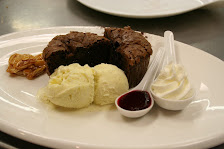
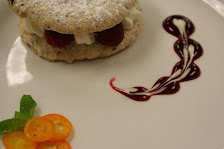
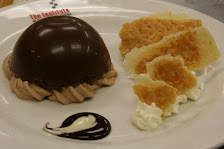
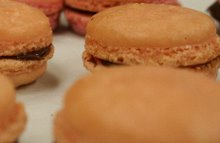
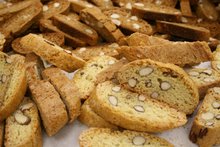




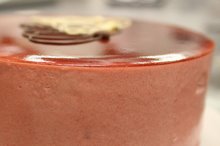



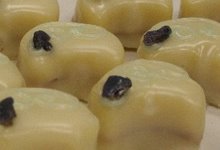




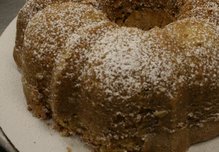
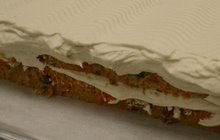










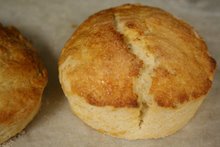


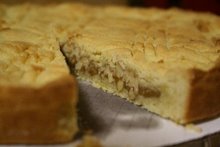












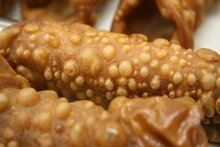


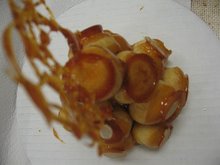
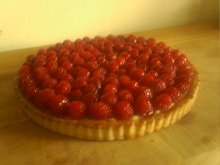


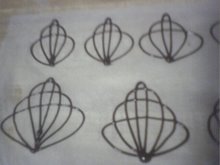


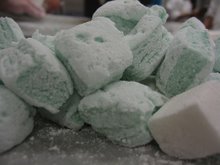

1 comment:
I was just reading about JELLO and it made me think of you.
"Because the collagen is processed extensively, the final product is not categorized as a meat or animal product by the US federal government."
How can you process bone so much that it no longer is classified as animal? Wierd.
You write well.
XO
DOUG Q
Post a Comment